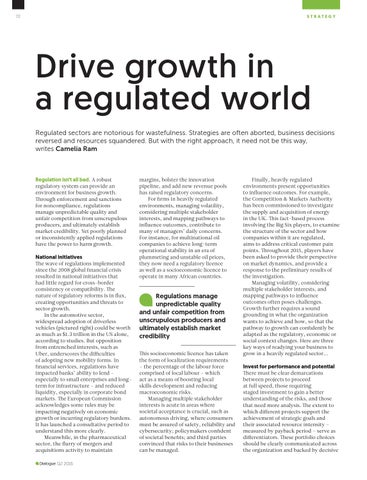strategy
72
Drive growth in a regulated world Regulated sectors are notorious for wastefulness. Strategies are often aborted, business decisions reversed and resources squandered. But with the right approach, it need not be this way, writes Camelia Ram
Regulation isn’t all bad. A robust regulatory system can provide an environment for business growth. Through enforcement and sanctions for noncompliance, regulations manage unpredictable quality and unfair competition from unscrupulous producers, and ultimately establish market credibility. Yet poorly planned or inconsistently applied regulations have the power to harm growth.
National initiatives
The wave of regulations implemented since the 2008 global financial crisis resulted in national initiatives that had little regard for cross-border consistency or compatibility. The nature of regulatory reforms is in flux, creating opportunities and threats to sector growth. In the automotive sector, widespread adoption of driverless vehicles (pictured right) could be worth as much as $1.3 trillion in the US alone, according to studies. But opposition from entrenched interests, such as Uber, underscores the difficulties of adopting new mobility forms. In financial services, regulations have impacted banks’ ability to lend – especially to small enterprises and longterm for infrastructure – and reduced liquidity, especially in corporate bond markets. The European Commission acknowledges some rules may be impacting negatively on economic growth or incurring regulatory burdens. It has launched a consultative period to understand this more clearly. Meanwhile, in the pharmaceutical sector, the flurry of mergers and acquisitions activity to maintain
margins, bolster the innovation pipeline, and add new revenue pools has raised regulatory concerns. For firms in heavily regulated environments, managing volatility, considering multiple stakeholder interests, and mapping pathways to influence outcomes, contribute to many of managers’ daily concerns. For instance, for multinational oil companies to achieve long-term operational stability in an era of plummeting and unstable oil prices, they now need a regulatory licence as well as a socioeconomic licence to operate in many African countries.
Regulations manage unpredictable quality and unfair competition from unscrupulous producers and ultimately establish market credibility This socioeconomic licence has taken the form of localization requirements – the percentage of the labour force comprised of local labour – which act as a means of boosting local skills development and reducing macroeconomic risks. Managing multiple stakeholder interests is acute in areas where societal acceptance is crucial, such as autonomous driving, where consumers must be assured of safety, reliability and cybersecurity; policymakers confident of societal benefits; and third parties convinced that risks to their businesses can be managed.
Finally, heavily regulated environments present opportunities to influence outcomes. For example, the Competition & Markets Authority has been commissioned to investigate the supply and acquisition of energy in the UK. This fact-based process involving the Big Six players, to examine the structure of the sector and how companies within it are regulated, aims to address critical customer pain points. Throughout 2015, players have been asked to provide their perspective on market dynamics, and provide a response to the preliminary results of the investigation. Managing volatility, considering multiple stakeholder interests, and mapping pathways to influence outcomes often poses challenges. Growth further requires a sound grounding in what the organization wants to achieve and how, so that the pathway to growth can confidently be adapted as the regulatory, economic or social context changes. Here are three key ways of readying your business to grow in a heavily regulated sector...
Invest for performance and potential
There must be clear demarcations between projects to proceed at full speed, those requiring staged investment to gain a better understanding of the risks, and those that need more analysis. The extent to which different projects support the achievement of strategic goals and their associated resource intensity – measured by payback period – serve as differentiators. These portfolio choices should be clearly communicated across the organization and backed by decisive
Dialogue Q2 2016
072-073_Dialogue_Q2_2016.indd 72
28/01/2016 12:25
